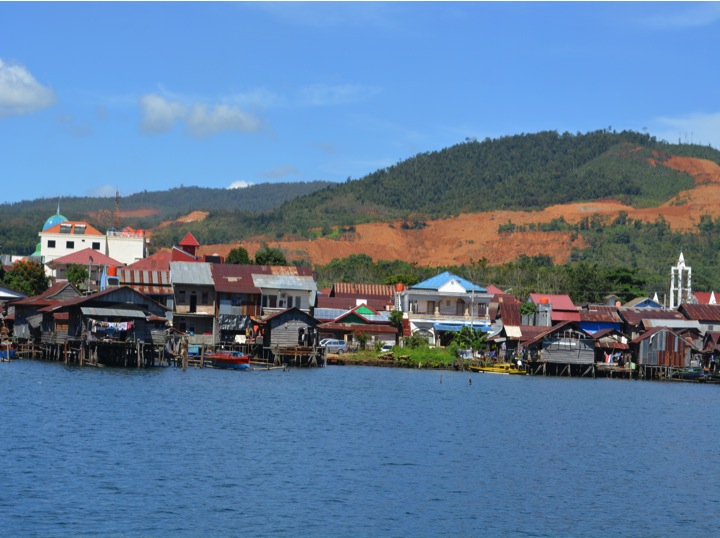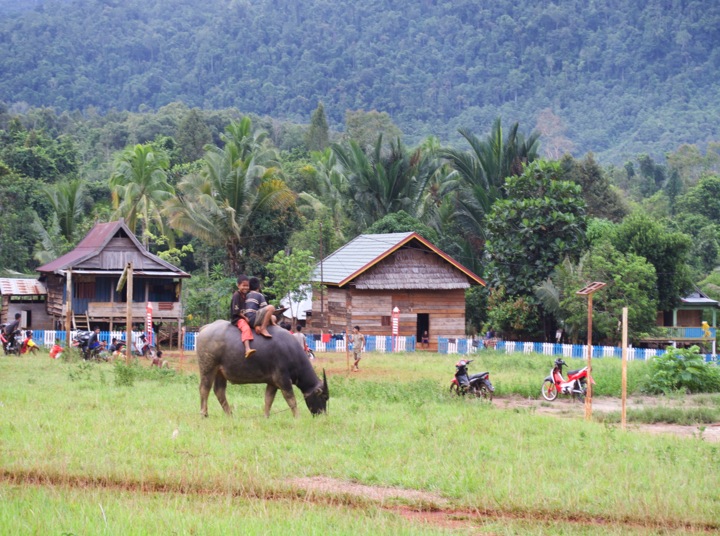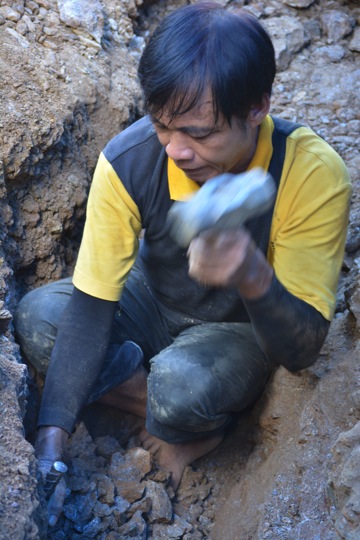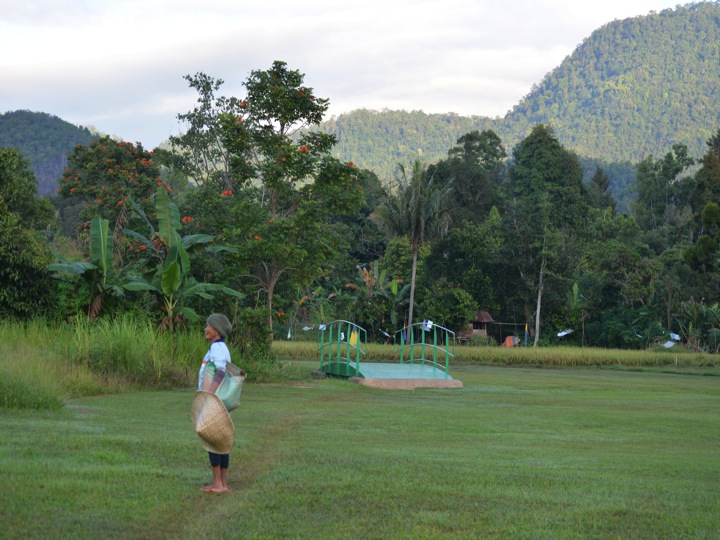The 2009 mining law and the community benefit in Sulawesi
Can mining deliver positive social and economic outcomes to the often-remote communities in their vicinities? Rhetoric surrounding the passage of the 2009 mining law emphasised the possibilities for returning more benefits to Indonesia’s people, especially from foreign investment projects. The administrative and financial arrangements of decentralisation, also intended to bring government and its activities closer to the people and provide the conditions under which mining benefits could flow directly to local communities. Has decentralisation post–2001, as well as changes in mining regulation since 2009, made it more likely that local communities can enjoy benefits of mining in their locales?
Sulawesi Island has been the site of many foreign-funded mining projects. Mining was given a boost in the years between 2001, when district governments acquired increased authority to issue permits, and 2014, when the ban on export of unprocessed ore in the 2009 law came into force. During this period, many rural districts were gripped by ‘mining fever’: attracting foreign and national investors in industrial mining, and interisland migrants and locals in small-scale mining.
Do these changed regulatory frameworks enable communities to more directly enjoy benefits of the exploitation of natural resources in their village estates? I look at the PT Vale mine in Sorowako, South Sulawesi which dates from the New Order; a project currently under development operated by SCM minerals in neighbouring Routa, in Southeast Sulawesi; and the interface of small-scale mining and local government-issued permits to national companies, in Bombana Southeast Sulawesi.
Sorowako, South Sulawesi – PT Vale
This mining and nickel processing project was established by a Contract of Work (CoW) signed with the Suharto government in 1967 under the 1967 mining law. Suharto opened the processing plant in 1976. The original contract was with International Nickel of Canada (Inco), which was bought by Vale of Brazil in 2008. By 2011, the name of the Indonesian subsidiary had been changed to PT Vale. The company is now 59.73 per cent owned by Vale Canada; 20.09 per cent by Sumitomo Metal mining; and 21.8 per cent publicly owned as a result of share divestment.
In 2014 Vale was the first foreign investor to renegotiate its CoW with the government to a mining licence (IUP), in accord with the 2009 law. This involved reducing its concession area to 118,435 hectares from the previous 190,510; increasing royalties paid from 0.9 to 2 per cent, further rising 3 per cent if the price of nickel increases to a set rate; and agreement to divest a further 20 per cent of shares to Indonesian parties within five years. They are able to extend the IUP for two further ten-year periods beyond the term of the CoW (2015) – that is, to 2035.
This project has been dogged by conflict with local people. A land grab facilitated by the Indonesian government under the terms of the 1967 foreign investment law destroyed their land-based agricultural, hunting and collecting livelihood and severely restricted the territory of the historic residential village. The government brokered a ‘ganti rugi’ (land sale at low local market prices) and paid only for land under permanent cultivation. No consideration was given to compensating for the forest land that provided for lading (dry fields), hunting, and collecting, including for tradable products like dammar and rattan.
The dispossessed indigenous community embarked on a regular cycle of protest, seeking compensation which included privileged access to employment and services such as clean water and electricity, as well as access to schools and hospitals. The need for these was felt acutely in the relative absence of government in the remote region. Inco regularly reneged on agreements on these matters, as management changed, or as the world price of nickel fluctuated. Before decentralisation, Sorowako was in the remotest corner of the vast district of Luwu with very poor transport connections. The company had a free hand to order its environment and its relations with locals. In addition, the district did not receive revenue from minerals , only from the sand and gravel, (termed ‘Galian C ‘) with all other taxes and royalties from the mining flowing to the centre.
The political space created by reformasi emboldened the indigenous people of Sorowako to undertake new waves of protests for recognition of lost land and livelihoods. What about decentralisation? The breaking up of the massive district of Luwu into three districts and a town (kotamadya) is an example where pemekaran (division of administrative units) made complete sense. Coupled with Law 25/1999 on the decentralisation of finance, the nickel mine now provides a steady flow of resources to the district government of East Luwu.

Samasang, a new suburb in Sorowako. (Kathryn Robinson)
However, many aspects of service delivery remain poor – for example, education, for which East Luwu ranks near the bottom in the province. Regional autonomy has engendered new attention to the ‘local’, but the district government does not support special claims of the dispossessed indigenous people of Sorowako. Rather, it promotes privileged access to employment for ‘orang lokal’, the people of the four subdistricts in which the mining project has operations. The indigenous Sorowakans, who still feel that their original grievance of dispossession has not been adequately addressed, experience this denial of their indigenous identity and associated rights as another blow. In their view, people in the four designated subdistricts have benefited from the development of the mine, while suffering no direct disadvantage, as they have. Currently, many of the young indigenous people are changing tack, pressing their claims using the rhetoric of special rights of ‘directly affected people’ (orang yang terdampak), rather than using the identity of ‘indigenous’ (orang asli).
The local government has supported some citizen movements to gain control of land that has been locked up in mining concession areas on the basis of livelihood, especially the land that has been released in the renegotiation of the contract. While they now tolerate farmers opening fields for commercial crops in designated forests, they are not giving any special consideration to the indigenous people who feel concerned about alternative livelihoods in their own place, including after mine closure.
The global climate for multinational mining companies has drastically changed since Inco first set foot in Sorowako. Since the 1990s, the global corporations have had to contend with increased global scrutiny led by NGOs and shareholder activism, including of community relations. This has resulted in the development of voluntary industry codes, and also the requirements under Indonesia’s 2007 law stipulating that businesses in the resource sector have to fund corporate social and environmental activities (CSR).
Rauta, Southeast Sulawesi – PT SCM
Rauta subdistrict is in North Konawe District in Southeast Sulawesi, bordering on East Luwu. Rio Tinto began exploring for nickel in the region in this isolated and undeveloped region in the 1990s and had hoped to sign a CoW before the long-anticipated revised mining law was passed. This did not happen, and the development was subject to the new regulations.
Rio Tinto had been forced to close its mine in Bougainville, Papua New Guinea in 1989 in the context of a civil war engendered in large part by their activities, and this has made them sensitive to the need to attend to relationships with local communities. They, like other MNCs, use the idiom of seeking a ‘social licence to mine’ (a variant of the concept of FPIC, ‘free prior and informed consent’) and avoid ‘community outrage’ which can cause obstructions and delays.
They conducted a comprehensive social baseline study of this remote region and deployed a community liaison team on the ground during exploration. This team was engaged in social preparation and worked with locals to strengthen the local agricultural economy. A comfortable familiarity grew between the mining company and the community while its footprint was still light on the ground. This is a distinct contrast to the shock that had confronted the people of Sorowako as they realised that their land was to be taken, in a process securitised by the military. The community team in Rauta had engaged in a series of consultations with the 2000 or so inhabitants.

Rauta, the town at the centre of the new mining development. (Kathryn Robinson)
While the company had always intended to build a smelter as required by the 2004 law, their investment partner (Sherritt International) with requisite experience then withdrew. Unable to find a replacement, Rio Tinto divested the Indonesian subsidiary company, Sulawesi Cahaya Minerals (SCM), to a national company in July 2014. This year, the company is proceeding to the social and economic impact assessment (AMDAL), the completion of which requires community consent. Procedures for AMDAL were firmed up in 2012. SCM seems committed to sustaining the good relations that have been built with locals and has retained the bare core of the community team. The team is now involved in the AMDAL and has consulted all the villages populations concerning the characteristics of people considered to be orang lokal and who hence have primary rights as beneficiaries, especially for employment.
Meanwhile, as mineral prices bust, pepper prices are booming and the area is experiencing considerable economic growth. This development is mainly due to the efforts of local farmers and their patrons, with some assistance from the microfinance institutions that SCM has established. The footprint of the concession area is relatively light and there is plenty of land for the farmers.
A Chinese-owned mining company began exploration for nickel in Rauta in 2016. It is very secretive and has not attempted to establish any community linkages, save for one local agent who recruits the small amount of labour they need. In 2016, five Chinese employees were deported for not having working visas. The experience with SCM has created an expectation of community consultation and engagement, and the attitude of the local people to this company is suspicious and hostile. It will be interesting to see if the company’s failure to secure a ‘social licence to mine’ will have any practical consequences as they ramp up operations.
Bombana, Southeast Sulawesi – ‘gold rush’
Bombana, in the western corner of Southeast Sulawesi, is experiencing a gold rush. Rumours began to spread circa 2005 and attracted small-scale miners to move from other sites, such as Kalimantan. Gold mining in Bombana is highly dangerous work as miners, including children, tunnel into the earth to pull up soil, and mercury is used to amalgamate ore particles.
Before the 2009 mining law, small-scale mining was licensed by the district government. Now all mining requires an IUP, and this has resulted in larger mining ventures obtaining licences (IUP) from the district heads. But since the democratic changes of reformasi, owners of mineable land are not easily displaced. The large companies have adapted by issuing ‘flags’ (sublicences) to landowners, who are then obligated under conditions in the IUP to sell their ore to the company with the licence. This is termed the mitra or partner system, where the mining licence is in fact a form of mercantile control of product sale. Within the IUP area, the sluice method of extracting gold ore and the use of mercury to amalgamate gold flecks remain essentially the same as with the independent small miners.

A community miner (of 'people's mining') in Bombana. (Kathryn Robinson)
The 2009 mining law has requirements that seem to protect local rights: the requirement for community consent in the AMDAL process and the obligation of the licence holder to rehabilitate the site. In practice, however, the latter is not enforced in Bombana. Companies use the excuse that if they rehabilitate, small independent miners will just dig up the area again. While companies pay a bond that is held against the requirement to rehabilitate, it is usually a small amount of money compared to the real costs involved. Environmental destruction goes largely unchecked – not only from the failure to remediate excavated land, but also the seepage of mercury-laden silt into waterways and further downstream effects.
To be sure, many locals have benefited from short-term economic gains from the sale of their gold, although they have no control over marketing. They have some formal control over their labour, but at what cost – to their health, to the environment and also to communities in the immediate environment and downstream?
While the changes in the mining law and the political shifts of decentralisation have brought some improvements in the ability of people to directly benefit from mining, many negative consequences remain. Local government has not proven to be a stronger advocate of the rights of mining affected communities, whether it be with regard to social, economic or health impacts.
Kathryn Robinson (kathryn.robinson@anu.edu.au) is emeritus professor of Anthropology in the School of Culture, History and Language at the ANU College of Asia and the Pacific.












